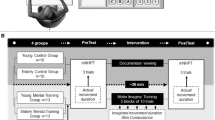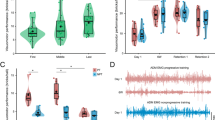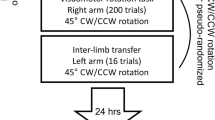Abstract
Sports psychology suggests that mental rehearsal facilitates physical practice in athletes and clinical rehabilitation attempts to use mental rehearsal to restore motor function in hemiplegic patients. Our aim was to examine whether mental rehearsal is equivalent to physical learning, and to determine the optimal proportions of real execution and rehearsal. Subjects were asked to grasp an object and insert it into an adapted slot. One group (G0) practiced the task only by physical execution (240 trials); three groups imagined performing the task in different rates of trials (25%, G25; 50%, G50; 75%, G75), and physically executed movements for the remaining trials; a fourth, control group imagined a visual rotation task in 75% of the trials and then performed the same motor task as the others groups. Movement time (MT) was compared for the first and last physical trials, together with other key trials, across groups. All groups learned, suggesting that mental rehearsal is equivalent to physical motor learning. More importantly, when subjects rehearsed the task for large numbers of trials (G50 and G75), the MT of the first executed trial was significantly shorter than the first executed trial in the physical group (G0), indicating that mental practice is better than no practice at all. Comparison of the first executed trial in G25, G50 and G75 with the corresponding trials in G0 (61, 121 and 181 trials), showed equivalence between mental and physical practice. At the end of training, the performance was much better with high rates of mental practice (G50/G75) compared to physical practice alone (G0), especially when the task was difficult. These findings confirm that mental rehearsal can be beneficial for motor learning and suggest that imagery might be used to supplement or partly replace physical practice in clinical rehabilitation.






Similar content being viewed by others
References
Beisteiner R, Hollinger P, Lindinger G, Lang W, Berthoz A (1995) Mental representations of movements. Brain potentials associated with imagination of hand movements. Electroencephalogr Clin Neurophysiol 96:183–193
Burhans RS, Richman CL, Bergey DB (1988) Mental imagery training: effects on running speed performance. Int J Sport Psychol 19:26–31
Caldara R, Deiber MP, Andrey C, Michel CM, Thut G, Hauert CA (2004) Actual and mental motor preparation and execution: a spatiotemporal ERP study. Exp Brain Res 159:389–399
Crammond DJ (1997) Motor imagery: never in your wildest dream. TINS 20(2):54–57
Dankert J, Ferber S, Doherty T, Steinmetz H, Nicolle D, Goodale MA (2002) Selective, non-lateralized impairement of motor imagery following right parietal damage. Neurocase 8:194–204
Decety J, Jeannerod M (1995) Mentally simulated movements in virtual reality: does Fitts’s law hold in motor imagery? Behav Brain Res 72(1–2):127–134
Decety J, Michel F (1989) Comparative analysis of actual and mental movement times in two graphic tasks. Brain Cogn 11(1):87–97
Decety J, Jeannerod M, Durozard D, Baverel G (1993) Central activation of autonomic effectors during mental simulation of motor actions in man. J Physiol 461:549–563
Decety J, Perani D, Jeannerod M, Bettinardi V, Tadary B, Woods R, Mazziotta JC, Fazio F (1994) Mapping motor representations with positron emission tomography. Nature 371(6498):600–602
Dickstein R, Dunsky A, Marcovitz E (2004) Motor imagery for gait rehabilitation in post-stroke hemiparesis. Phys Ther 84(12):1167–1177
Dominey P, Decety J, Broussolle E, Chazot G, Jeannerod M (1995) Motor imagery of a lateralized sequential task is asymmetrically slowed in hemi-parkinsonien’s patients. Neuropsychologia 33(6):727–741
Fadiga L, Buccino G, Craighero L, Fogassi L, Gallese V, Pavesi G (1999) Corticospinal excitability is specially modulated by motor imagery: a magnetic stimulation study. Neuropsychologia 37:147–158
Feltz DL, Landers DM (1983) The effects of mental practice on motor skill learning and performance: a meta-analysis. J Sport Psychol 5:25–57
Frak V, Paulignan Y, Jeannerod M (2001) Orientation of the opposition axis in mentally simulated grasping. Exp Brain Res 136:120–127
Gaggioli A, Morganti F, Walker R, Meneghini A, Alcaniz M, Lozano JA, Montesa J, Gil JA, Riva G (2004) Training with computer-supported motor imagery in post-stroke rehabilitation. Cyberpsychol Behav 7(3):327–332
Gentili R, Papaxanthis C, Pozzo DT (2006) Improvement and generalization of arm motror performance through motor imagery practice. Neuroscience 137:761–772
Gerardin E, Sirigu A, Lehericy S, Poline JBB, Gaymard B, Marsault C, Agid Y, Le Bihan D (2000) Partially overlapping neural networks for real and imagined hand movements. Cereb Cortex 10(11):1093–1104
Hanakawa T, Immisch I, Toma K, Dimyan MA, Van Gelderen P, Mark Hallett M (2003) Functional properties of brain areas associated with motor execution and imagery. J Neurophysiol 89:989–1002
Hashimoto R, Rothwell JC (1999) Dynamic changes in corticospinal excitability during motor imagery. Exp Brain Res Mar 125(1):75–81
Hird JS, Landers DM, Thomas JR, Horan JJ (1991) Physical practice is superior to mental practice in enhancing cognitive and motor task performance. J Sport Exerc Psychol 13:281–293
Jackson PL, Lafleur MF, Malouin F, Richards C, Doyon J (2001) Potential role of mental practice using motor imagery in neurologic rehabilitation. Arch Phys Med Rehabil 82(8):1133–1141
Jackson PL, Lafleur MF, Malouin F, Richards CL, Doyon J (2003) Functional cerebral reorganization following motor sequence learning through mental practice with motor imagery. Neuroimage 20(2):1171–1180
Jackson PL, Doyon J, Richards CL, Malouin F (2004) The efficacy of combined physical and mental practice in the learning of a foot-sequence task after stroke: a case report. Neurorehabil Neural Repair 18(2):106–111
Jeannerod M (1995) Mental imagery in the motor context. Neuropsychologia 33(11):1419–1432
Jeannerod M (2001) Neural simulation of action: a unifying mechanism for motor cognition. Neuroimage 14:S103–S109
Jeannerod M, Frak V (1999) Mental imaging of motor activity in humans. Curr Opin Neurobiol 9:735–739
Lacourse MG, Turner JA, Randolph-Orr E, Schandler SL, Cohen MJ (2004) Cerebral and cerebellar sensorimotor plasticity following motor imagery-based mental practice of a sequential movement. J Rehabil Res Dev 41(4):505–524
Lafleur MF, Jackson PL, Malouin F, Richards CL, Evans AC, Doyon J (2002) Motor learning produces parallel dynamic functional changes during the execution and imagination of sequential foot movements. Neuroimage 16(1):142–157
Liu KP, Chan CC, Lee TM, Hui-Chan CW (2004) Mental imagery for promoting relearning for people after stroke: a randomized controlled trial. Arch Phys Med Rehabil 85:1403–1408
McFarland DJ, Miner LA, Vaughan TM, Wolpaw JR (2000) Mu and beta rhythm topographies during motor imagery and actual movements. Brain Topogr 12(3):177–186
Mulder T, Zijlstra S, Zijlstra W, Hochstenbach J (2004) The role of motor imagery in learning a totally novel movement. Exp Brain Res 154:211–217
Ozel S, Larue J, Dosseville F (2004) Effect of arousal on internal clock speed in real action and mental imagery. Can J Exp Psychol 58(3):196–205
Page SJ, Levine P, Sisto SA, Johnston MV (2001) Mental practice combined with physical practice for upper-limb motor deficit in subacute stroke. Phys Ther 81(8):1455–1462
Papaxanthis C, Pozzo T, Skoura X, Chieppati M (2002) Does order and timing in performance of imagined and actual movements affect the motor imagery process? The duration of walking and writing task. Behav Brain Res 134:209–215
Papaxanthis C, Pozzo T, Kasprinski R, Berthoz A (2003) Comparison of actual and imagined execution of whole-body movements after a long exposure to microgravity. Neurosci Lett 339:41–44
Pascual-Leone A, Nguyet D, Cohen LG, Brasil-Neto JP, Cammarota A, Hallett M (1995) Modulation of muscle responses evoked by transcranial magnetic stimulation during the acquisition of new fine motor skills. J Neurophysiol 74:1037–1045
Porretta DL, Surburg PR (1995) Imagery and physical practice in the acquisition of gross motor timing of coincidence by adolescents with mild mental retardation. Percept Mot Skills 80(3 Pt 2):1171–1183
Ranganathan VH, Siemionow V, Liu JZ, Sahgal V, Yue GH (2004) From mental power to muscle power—gaining strength by using the mind. Neuropsychologia 42:944–956
Romero DH, Lacourse MG, Lawrence KE, Schandler S, Cohen MJ (2000) Event-related potentials as a function of movement parameter variations during motor imagery and isometric action. Behav Brain Res 117:83–96
Sirigu A, Duhamel JR, Cohen L, Pillon B, Dubois B, Agid Y (1996) The mental representation of hand movements after parietal cortex damage. Science 273(5281):1564–1568
Stevens JA, Stoykov MEP (2003) Using motor imagery in the rehabilitation of hemiparesis. Arch Phys Med Rehabil 84:1090–1092
Yaguez L, Nagel D, Hoffman H, Canavan AGM, Wist E, Homberg V (1998) A mental route to motor learning: improving trajectorial kinematics through imagery training. Behav Brain Res 90:95–106
Yoo E, Park E, Chung B (2001) Mental practice effect on line-tracing accuracy in persons with hemiparetic stroke: a preliminary study. Arch Phys Med Rehabil 82:1213–1218
Yue G, Cole KJ (1992) Strength increases from the motor program: comparison of training with maximal voluntary and imagined muscle contractions. J Neurophysiol 67(5):1114–1123
Acknowledgments
We are grateful to Pr. Marc Jeannerod, Drs. Martine Meunier and Richard Walker for their insightful comments and discussions. This work was supported by EU grant: IST programme (Project I-Learning, IST 2001-38861).
Author information
Authors and Affiliations
Corresponding author
Rights and permissions
About this article
Cite this article
Allami, N., Paulignan, Y., Brovelli, A. et al. Visuo-motor learning with combination of different rates of motor imagery and physical practice. Exp Brain Res 184, 105–113 (2008). https://doi.org/10.1007/s00221-007-1086-x
Received:
Accepted:
Published:
Issue Date:
DOI: https://doi.org/10.1007/s00221-007-1086-x




